Zoom
Trash

Online learning could provide answer. Undergraduate application numbers in South Africa alone show that hundreds of thousands of prospective first-year students will not be accommodated in the country’s universities next year.
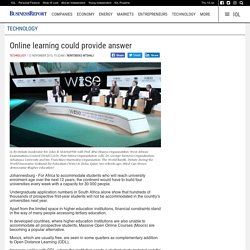
Apart from the limited space in higher education institutions, financial constraints stand in the way of many people accessing tertiary education. In developed countries, where higher education institutions are also unable to accommodate all prospective students, Massive Open Online Courses (Moocs) are becoming a popular alternative. Moocs, which are usually free, are seen in some quarters as complementary addition to Open Distance Learning (ODL). However, unlike with ODL, where the institution sends a student study material and the student returns assignments to be marked by tutors, Moocs are more about self-paced peer-learning.
The tertiary education co-ordinator at The World Bank, Francisco Marmolejo, said there were only about 200 million people in higher education globally. Udemy L&D Roundup: Your Top 5 Reads. It’s an exciting time to be in learning and development (L&D) where disruption and innovation are the name of the game.

Today’s L&D professionals are forced to rethink how they approach workplace learning and constantly think out of the box when it comes to nurturing talent. And it’s not just new technologies that are changing the way people learn and teach, but it’s also novel ideas, breakthroughs in neuroscience research, and innovative approaches to learning. However, we know that it can also be a little overwhelming to stay up to date on all the new information out there. To help you stay on top of all the great L&D news out there, I’ve curated some of the most thought-provoking reads I’ve come across recently.
Red Balloon Project Articles. Re-Imagining Undergraduate EducationAn article entitled "Re-Imagining Undergraduate Education" appears in AASCU's Public Purpose magazine.
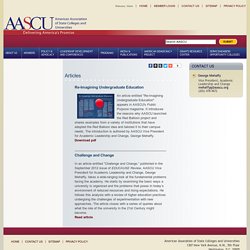
It introduces the reasons why AASCU launched the Red Balloon project and shares examples from a variety of institutions that have adopted the Red Balloon idea and tailored it to their campus needs. The introduction is authored by AASCU Vice President for Academic Leadership and Change, George Mehaffy. Download pdf Challenge and ChangeIn an article entitled “Challenge and Change,” published in the September 2012 issue of EDUCAUSE Review, AASCU Vice President for Academic Leadership and Change, George Mehaffy, takes a wide-ranging look at the fundamental problems facing the academy. He starts by examining the basic ways a university is organized and the problems that poses in today’s environment of reduced resources and rising expectations. Next Generation Learning Challenges - NGLC. Global E-Learning Market in Steep Decline, Report Says.
Market Trends Global E-Learning Market in Steep Decline, Report Says The worldwide self-paced e-learning market is declining at a precipitous rate, according to a recent report released by Ambient Insight Research, a Washington state-based market research firm.
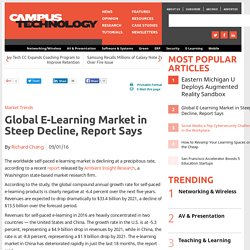
According to the study, the global compound annual growth rate for self-paced e-learning products is clearly negative at -6.4 percent over the next five years. Revenues are expected to drop dramatically to $33.4 billion by 2021, a decline of $13.5 billion over the forecast period.
State-of-the-art education software often doesn’t help students learn more, study finds. Even proponents of educational technology admit that a lot of software sold to schools isn’t very good.
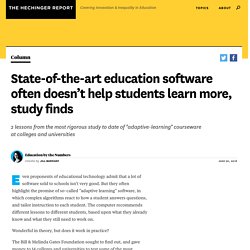
But they often highlight the promise of so-called “adaptive learning” software, in which complex algorithms react to how a student answers questions, and tailor instruction to each student. Technology in Schools Faces Questions on Value. The Power of Twelve. Editor’s Note: The following is an excerpt from Real Teachers: True Stories of Renegade Educators, by Stuart Grauer (SelectBooks, 2013), which was a finalist for a 2014 San Diego Book Award.
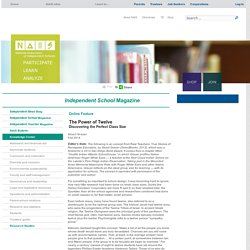
It comes from a chapter titled “Hostile Indian Attacks Schoolhouse,” in which Grauer profiles Native American Roger White Eyes — a teacher at the Red Cloud Indian School on the Lakota’s Pine Ridge Indian Reservation. Taking part in the Wounded Knee Memorial Motorcycle Ride with Roger White Eyes and other Native Americans, Grauer reflects on the ideal group size for learning — with its application for schools.
The excerpt is reprinted with permission of the publisher and author. For something so important to school design, it was becoming hard to ignore how very little research had been done on small class sizes. Even before Jesus, many have found twelve, also referred to as a duedecuple, to be the optimal group size.
Getfile. What Education Technology Could Look Like Over the Next Five Years. In a fast-moving field like education technology, it’s worth taking a moment to take stock of new developments, persistent trends and the challenges to effective tech implementation in real classrooms.
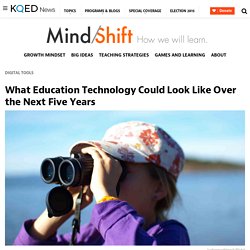
The NMC Horizon 2015 K-12 report offers a snapshot of where ed tech stands now and where it is likely to go in the next five years, according to 56 education and technology experts from 22 countries. Deeper Learning: The expert panel identified several long-term trends that will greatly influence the adoption of technology in classrooms over the next five years and beyond. Failure Is Essential to Learning. Why Ed Tech Is Not Transforming How Teachers Teach. Student Authentication and Security Concerns for Online Learning » The Online Learning Curve.
As much as Internet based systems are common for banking, product ordering, and other personal services that were handled face to face in the past, distance learning presents a different “twist” on security.
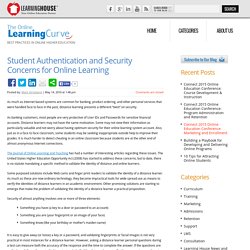
As banking customers, most people are very protective of User IDs and Passwords for sensitive financial accounts. Distance learners may not have the same motivation. Some may not view their information as particularly valuable and not worry about having optimum security for their online learning system account. Also, just as in a face to face classroom, some students may be seeking inappropriate outside help to improve their grades. 5 Keys to Flipped Learning Success. Flipped Classroom.
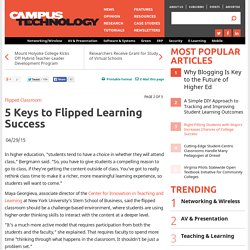
Collaborative Learning and Online Assessments Enhance Developmental Math at Ohio University-Chillicothe. Project Spotlight Page 2 of 2 Collaborative Learning and Online Assessments Enhance Developmental Math at Ohio University-Chillicothe Sometimes it's Lafreniere providing that assistance, and sometimes it's a fellow student.
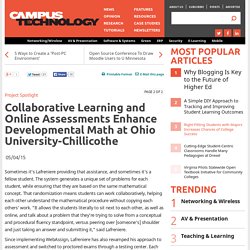
The system generates a unique set of problems for each student, while ensuring that they are based on the same mathematical concept. That randomization means students can work collaboratively, helping each other understand the mathematical procedure without copying each others' work.
Untitled. Allison Rossett — She works on learning and technology in a way that is creative, concrete and quirky. Tsc-retention-and-engagement. Of screencast in e-learning. The Flipped Classroom, as most know, has become quite the buzz in education. Its use in higher education has been given a lot of press recently. The purpose of this post is to: Design Systems: The Cure for the Responsively-Challenged Site. In my previous post, I reviewed some of the characteristics of responsively-challenged sites. I ended with this mantra: To move forward, we have to discard the idea of web pages and instead create design systems. Tomorrow’s web will be designed and built from collections of content modules, each optimized to provide the best experience for each type of viewing device. Today I’ll outline a new responsive process that we’re using at Hanson to create a better end product with fewer wasted steps.
The core of the new process is tighter collaboration between the people who plan and design web experiences. The Team First, let me introduce the collaborators: The content strategist develops the messaging strategy of a project by assessing audience information needs, auditing existing content, researching trends, and creating findable, relevant and on-brand content in multiple forms. The Process. What's Next for E-Textbooks? Digital Textbooks Page 6 of 6 What's Next for E-Textbooks? Adaptivity is in a transitional moment, Ferreira noted. EDU-PLP_Seven_Survival_Skills. Intro to communities of practice. The term “community of practice” is of relatively recent coinage, even though the phenomenon it refers to is age-old. The concept has turned out to provide a useful perspective on knowing and learning. A growing number of people and organizations in various sectors are now focusing on communities of practice as a key to improving their performance.This brief and general introduction examines what communities of practice are and why researchers and practitioners in so many different contexts find them useful as an approach to knowing and learning.
What are communities of practice? Note that this definition allows for, but does not assume, intentionality: learning can be the reason the community comes together or an incidental outcome of member’s interactions. Not everything called a community is a community of practice. Eli3009.pdf. Slow Education - Slow Education: Deeper Learning...